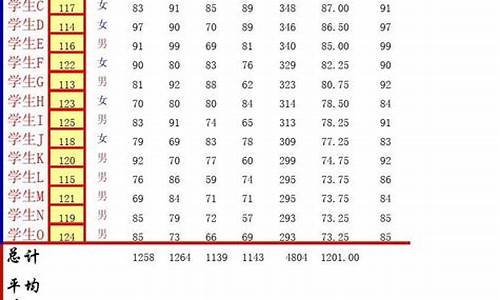您现在的位置是: 首页 > 高考调剂 高考调剂
山西2017高考英语试题_山西2017高考英语试题解析
tamoadmin 2024-06-30 人已围观
简介1.2017年高考英语备考:地点副词的用法2.英语2017高考调研答案3.高考领航2017英语答案大全说到完形填空,本人当年的分数还是不错的,当时也比较得心应手,哈哈。不知道大家对完形填空会不会重视,其实它的占比还是很大的,属于中等偏上的难度。据数据统计,即便超过100分的考生,完形填空的准确率大部分也只有50%,或者更低。其实在课堂上老师分享过过很多解题方法,但这些方法都是传统的也是必备的方法,
1.2017年高考英语备考:地点副词的用法
2.英语2017高考调研答案
3.高考领航2017英语答案大全

说到完形填空,本人当年的分数还是不错的,当时也比较得心应手,哈哈。不知道大家对完形填空会不会重视,其实它的占比还是很大的,属于中等偏上的难度。据数据统计,即便超过100分的考生,完形填空的准确率大部分也只有50%,或者更低。
其实在课堂上老师分享过过很多解题方法,但这些方法都是传统的也是必备的方法,配合另外一些方法才能提高准确率。
高考英语完形填空的核心主要考察3点,我来和大家好好聊聊。
一、词汇我觉得英语完形填空最重要的还是词汇的掌握,这种题一般考察的就是实义词,包括名词、形容词、副词。出题方向包括其同义词、反义词、易混词等。经常出现的考察点是,动词搭配不同的介词,会有不同释义。如果看到这类题,需要想明白词汇的意思,避免模棱两可的情况发生。
举例:
We will look out for each other and that's how we will ____ this difficulty.
A.get away B.get off
C.get out ? D.get through
get away:离开;逃脱
get off:脱下;动身去某地
get out:离开;出去
get through:度过,熬过(困难时期等)
明白这几个词的意思肯定是第一步,接着要看原文的提示,由此能看出,这个词组后的名词是difficulty,根据句意,选D,意思是我们彼此照料,这便是我们渡过难关的方式。
二、语法语法是完形填空的主要考察点,总结一些完形填空主要考察的语法内容:
名词词形:单复数变形,名词的可数和不可数;
动词词形:包括动词的时态,语态,语气,分词,动名词,不定式等结构;
词组搭配:这要看平常的积累了,如果遇到要注意了;
主谓一致:语法一致原则、意义一致原则、就近原则;
比较级:重视形容词、副词的比较形式的应用、冠词以及不定代词。
这部分其实整体不算很难,但需要很熟悉,平时要多积累、多总结,把常用常考的部分记在笔记本上,方便复习。
举例:
Ask your friends or parents to save_____envelopes for you.
A.used ? B.using ?
C.wasted ? D.good
让你的朋友或父母为你保留____信封。因为能判断,肯定是填使用过的,而use的分词used是形容词,使用过的;动名词using则没有形容词的词性,可以判断这题选A。
三、语意这是完形填空的考察重点,要求大家对整体有全面的了解,其实就是文章的中心思想,每道题的答案基本都会指向这个中心思想。读懂文章的中心思想,就能提高答题准确率。
很多人还是懵的,其实英文文章有个简单的现象,90%的文章和段落都是总分结构。由此可以推断,一篇文章第一段第一句,往往就是文章中心意思;而某个段落首句,基本就是该段落主题。高考英语完形填空,通常第一段第一句就是文章中心意思,大家看懂第一句,一般就能知道整篇文章的发展脉络了。
说到这,大家还要明白一点,完形填空的几大类型,主要分为:议论文、说明文以及记叙文。
议论文和说明文一般是这样的套路,第一段第一句说明一种情况,然后开始举例,证明这种情况的存在;而记叙文第一句就是讲故事,接着分叉,一是畅通无阻的路线,二是历经磨难的路线。不管哪种,最后都成功了。
这里就不举例了,这样说还是很好理解的。
三大框架之下,其实还能延伸很多,下面为大家延伸一些常用的技巧:
and前后有同义词,but前后有反义词
任何包含有and的句子,不管有没有空,一定要找到and并列的两个词。特别是空出来的句子,如果有and,就找and后紧接着的那个词的同义词,一般就是答案。还有含but的句子,前后肯定意思相反,很多时候but前后找反义词,答案就是它。
比如2017年全国卷1完形填空:I myself went through this ___41___process and found something that has changed my___42___ at college for the better.
41. A. searching B. planing C. natural D. formal
这个题and后的词为found,那么A选项中searching为同义词,答案就是A。
遇到生词猜加删
如果是动词,统译为:做、整、搞、来、去、在(哪个通顺用哪个),然后猜动词的意思;如果是名词,统译为:某人、某物、某事;如果是形容词副词,删掉不看。
比如2015年全国卷2完形填空:But it may well be that the learning you really want ___22___ somewhere else instead.
22. A. passed B. works C. lies D. ends
副词well删掉,really删掉,else删掉,instead删掉。然后翻译为:但是这可能是那样的,那个学习你想要的______某个地方。空格是动词,主语是“那个学习”,宾语是“某个地方“,空格填“在”比较合适。passed是路过,works是工作,lies是躺着,ends是结束,最接近“在”的意思那只能是躺着了,答案选C。
理清逻辑关系
这主要涉及句子长的语言单位,比如句群、段落、篇章等。因为它们之间肯定有内在联系的词语,这些词叫作“语篇标志”。(这里要注意上文中的转折词及连词等)。
比如2014课标II卷:Joe Simpson and Simon Yates were the first people to climb the West Face of the Siula Grande in the Andes mountains .They reached the top 41____ ,but on their way back conditions were very 42___ .
41. A. hurriedly B. carefully C. successfully D. early
这里连词but提示上下文存在转折关系,下文提到Joe在回来的路上摔伤了腿,那么回程肯定困难,登顶成功(successfully)
真的无解看首段
有时我们会遇到实在没办法的题目,这时候不要慌,赶紧看看首段首句,这就是文章的主题、大背景。在选择选项的时候,再想一想,填什么词能把主题说清楚,如果这个单词放在句子后后可以和第一段第一句相呼应,一般就是答案。
这里就不举例了,还是比较容易理解的。
总体来看,想要提升完形填空的准确率,还是要熟能生巧,因为过犹不及,希望大家能打牢基础,再结合上面为大家总结的方法,一定可以拿一个高分的。
2017年高考英语备考:地点副词的用法
1 不定式作宾语
1) 动词+ 不定式
afford, aim, appear, agree, arrange, ask, be, decide, bother, care, choose, come, dare, demand, desire, determine, expect, elect, endeavor, hope, fail, happen, help, hesitate, learn, long, mean, manage, offer, ought, plan, prepare, pretend, promise, refuse, seem, tend, wait, wish, undertake
The driver failed to see the other car in time. 司机没能及时看见另一辆车。
I happen to know the answer to your question. 我碰巧知道你那道问题的答案。
2) 动词+不定式;动词+宾语+不定式
ask, beg, choose, expect, hate, help intend like, love, need prefer, prepare, promise, want, wish
I like to keep everything tidy. 我喜欢每件东西都保持整洁。
I like you to keep everything tidy. 我喜欢你使每件东西都保持整洁。
I want to speak to Tom. 我想和汤姆谈话。
I want you to speak to Tom. 我想让你和汤姆谈话。
3) 动词+疑问词+ to
decide, know, consider forget, learn, remember, show, understand, see, wonder, hear, find out, explain, tell
Please show us how to do that. 请演示给我们如何去做。
There are so many kinds of tape-recorders on sale that I can't make up my mind which to buy.有这么多的录音机,我都拿不定主意买哪一种。
注意
疑问词带不定式在句中作成分时,谓语动词用单数。如:The question is how to put it into practice. 问题是怎样把它付诸实施。
2. 不定式作补语
1) 动词+宾语+不定式(to do)
advise, allow, appoint, believe, cause, challenge, command, compel, consider, declare, drive, enable, encourage, find, forbid, force, guess, hire, imagine, impel, induce, inform, instruct, invite, judge, know, like, order, permit, persuade, remind, report, request, require, select, send, state, suppose, tell, think, train, trust, understand, urge, warn
a.Father will not allow us to play on the street. 父亲不让我们在街上玩耍。
b.We believe him to be guilty. 我们相信他是有罪的。
Find 的特殊用法
Find 后可用分词做宾补,或先加形式宾语,再加形容词,最后加带to 的动词不定式。find后也可带一个从句。此类动词还有get,have。
I found him lying on the ground.
I found it important to learn.
I found that to learn English is important.
典型例题
The next morning she found the man ___ in bed,dead.
A. lying B. lie C. lay D. laying
答案:A.find的宾语后面,用分词或分词短语,起宾语补足语作用。现在分词表达主动,也表达正在进行,过去分词表达被动。
2) to + be 的不定式结构,作补语的动词。
acknowledge, believe, consider, think, declare(声称), discover, fancy(设想), feel, find, guess, judge, imagine, know, prove, see(理解), show, suppose, take(以为), understand
We consider Tom to be one of the best students in our class. 我们认为汤姆是班上的学生之一。
典型例题
Charles Babbage is generally considered ___ the first computer.
A. to invent B. inventing C. to have invented D. having invented
答案:A. 由consider to do sth. 排除B、D。. 此句只说明发明这一个事实,不定式后用原形即可。而C为现在完成时,发明为点动词一般不用完成时,且此处也不强调对现在的影响,因此不选C。
3) to be +形容词
seem, appear, be said, be supposed, be believed, be thought, be known, be reported, hope, wish, desire, want, plan, expect, mean
The book is believed to be uninteresting. 人们认为这本书没什么意思。
4) there be+不定式
believe, expect, intend, like, love, mean, prefer, want, wish, undrstand
We didn't expect there to be so many people there. 我们没料到会有那么多人在哪里。 注意
有些动词需用as 短语做补语,如regard, think believe, take, consider.
We regard Tom as our best teacher. 我们认为汤姆是我们的老师。
Mary took him as her father . 玛丽把他当作自己的父亲。
3. 不定式作主语
1) It's easy (for me) to do that. 我做这事太容易了。
easy, difficult, hard, important, possible, impossible, comfortable, necessary, better; the first, the next, the last, the best, too much, too little, not enough
It's so nice to hear your voice. 听到你的声音真高兴。
It's necessary for you to lock the car when you do not use it. 当你不用车的时候,锁车是有必要的。
2) It's very kind of you to help us. 他帮助我们,他真好。
kind, nice, stupid, rude, clever, foolish, thoughtful, thoughtless, brave, considerate(考虑周到的), silly, selfish(自私的)
It was silly of us to believe him. 我们真愚蠢,竟然相信了他。
It seemed selfish of him not to give them anything. 他不给他们任何东西,这显得太自私了。 注意
1) 其他系动词如,look,appear等也可用于此句型
2) 不定式作为句子成分时,动词用单数形式。
3) 当不定式作主语的句子中又有一个不定式作表语时,不能用It is? to?的句型
(对)To see is to believe. 百闻不如一见。(错)It is to believe to see.
It's for sb.和 It's of sb.
1) for sb. 常用于表示事物的特征特点,表示客观形式的形容词,如easy, hard, difficult, interesting, impossible等:
It's very hard for him to study two languages. 对他来说学两门外语是很难的。
2) of sb的句型一般用表示人物的性格,品德,表示主观感情或态度的形容词,如good, kind, nice, clever, foolish, right。
It's very nice of you to help me. 你来帮助我,你真是太好了。
for 与of 的辨别方法
用介词后面的代词作主语,用介词前边的形容词作表语,造个句子。如果道理上通顺用of,不通则用for。如:You are nice. (通顺,所以应用of)。He is hard. (人是困难的,不通,因此应用for。)
4. 不定式作表语
不定式可放在be动词后面,形成表语。例如:
My work is to clean the room every day.
His dream is to be a doctor.
5. 不定式作定语
不定式做定语通常要放在被修饰的词后。例如:
I have a lot of work to do.
So he made some candles to give light.
6. 不定式作状语
1) 目的状语
To? only to (仅仅为了), in order to, so as to, so(such)? as to? (如此?以便?) He ran so fast as to catch the first bus. 他飞快地跑以便赶上第一班车。
I come here only to say good-bye to you. 我来仅仅是向你告别。
2) 作结果状语,表事先没有预料到的,要放在句子后面。
What have I said to make you angry.
He searched the room only to find nothing.
3) 表原因
I'm glad to see you.
典型例题
The chair looks rather hard, but in fact it is very comfortable to ___.
A. sit B. sit on C. be seat D. be sat on
答案:B. 如果不定式为不及物动词,其后应有必要的介词。当动词与介词连用时,常位于"形容词+动词不定式"结构的末尾。
用作介词的to
to 有两种用法:一为不定式+动词原形; 一为介词+名词/动名词, to 在下面的用法中是第二种,即to+ 名词/动名词:admit to承认,confess to承认,be accustomed to 习惯于,be used to 习惯于,stick to 坚持,turn to开始,着手于,devote oneself to 献身于,be devoted to 致力于, look forward to 盼望,pay attention to
注意
省to 的动词不定式
1) 情态动词 ( 除ought 外,ought to):
2) 使役动词 let, have, make:
3) 感官动词 see, watch, look at, notice , observe, hear, listen to, smell, feel, find 等后作宾补,省略to。
注意
在被动语态中则to 不能省掉。
I saw him dance. =He was seen to dance.
The boss made them work the whole night.=They were made to work the whole night.
4) would rather,had better:
5) Why? / why not?:
6) help 可带to,也可不带to, help sb (to) do sth:
7) but和except:but前是动词do时,后面出现的动词用不带to的动词不定式。
8) 由and, or和than连接的两个不定式,第二个to 可以省去:
9) 通常在discover, imagine, suppose, think, understand等词后,可以省去to be:He is supposed (to be) nice. 他应该是个好人。举例:He wants to move to France and marry the girl. He wants to do nothing but go out. 比较:He wants to do nothing but go out. He wants to believe anything but to take the medicine.
典型例题
1) ---- I usually go there by train.
---- Why not ___ by boat for a change?
A. to try going B. trying to go C. to try and go D. try going
答案:D. why not 后面接不带to 的不定式,因此选D。
2) Paul doesn't have to be made ___. He always works hard.
A. learn B. to learn C. learned D. learning
答案:B. make后接不带to 的动词不定式,当其用于被动时,to 不可省略。
动词不定式的否定式
Tell him not to shut the window?
She pretended not to see me when I passed by. 我走过的时候,她假装没看见。
典型例题
1) Tell him ___ the window.
A. to shut not B. not to shut C. to not shut D. not shut
答案:B。 tell sb to do sth 的否定形式为tell sb not to do sth.
2) She pretended ___ me when I passed by.
A. not to see B. not seeing C. to not see D. having not seen
答案:A。 pretend 后应接不定式。其否定形式为pretend not to do sth.。
3) Mrs. Smith warned her daughter ___ after drinking.
A. never to drive B. to never driver C. never driving D. never drive
答案:A。warn sb to do sth. 的否定形式为warn sb not to do sth. 此处用的是否定词never.
4) The boy wanted to ride his bicycle in the street,but his mother told him ____.
A. not to B. not to do C. not do it D. do not to
答案:A。not to 为not to do it 的省略形式。可以只用to这个词,而不必重复整个不定式词组。及物动词do后应有名词、代词等,否则不对,因此B,D不对。
5) The patient was warned ___ oily food after the operation.
A. to eat no B. eating not C. not to eat D. not eating
答案:C。warn一词要求后用不定式,此处为不定式的被动,否定形式为be warned not to do。 不定式的特殊句型too?to?
1) too?to 太?以至于?
He is too excited to speak. 他太激动了,说不出话来。
---- Can I help you ? 需要我帮忙吗?
---- Well, I'm afraid the box is too heavy for you to carry it, but thank you all the same. 不用了。这箱子太重,恐怕你搬不动。谢谢您。
2) 如在too前有否定词,则整个句子用否定词表达肯定, too 后那个词表达一种委婉含义,意 为"不太"。
It's never too late to mend. (谚语) 改过不嫌晚。
3) 当too 前面有only, all, but时,意思是:非常? 等于very。
I'm only too pleased to be able to help you. 我非常高兴能帮助你。
He was but too eager to get home. 他非常想回家。
不定式的特殊句型so as to
1) 表示目的;它的否定式是so as not to do。
Tom kept quiet about the accident so as not to lose his job. 汤姆对事故保持沉默是为了不丢掉他的工作。
Go in quietly so as not to wake the baby. 轻点进去,别惊醒了婴儿。
2) so kind as to ---劳驾
Would you be so kind as to tell me the time? 劳驾,现在几点了。
不定式的特殊句型Why not
"Why not +动词原形"表达向某人提出建议,翻译为:"为什么不" "干吗不"
例如:Why not take a holiday? 干吗不去度假?
英语2017高考调研答案
地点副词
具体如下:
地点副词指表示地点的副词和表示位置关系的副词统称为地点副词.常见的这类副词有:
表示地点的:
here,there,home,upstairs,downstairs,anywhere,everywhere,nowhere,somewhere,abroad,elsewhere等.
表示位置关系的:
above,below,down,up,out,in,across,back,along,over,round,around,away,near,off,on,inside,outside,past等.
在表示位置关系的副词中,有些副词也可用作介词(如:
above,over,beyond,around,below,down,up,in,along,near,off,on,past等),在没有宾语时就是副词,有宾语时就是介词,如:
Come in,please.(副词)
They live in the next room.(介词)
Let's take along.(副词)
Let's walk along this street.(介词)
She looked around.(副词)
They sat around the table.(介词)
Let's go on with the work...(副词)
What subject will you speak on?(介词)
四、地点副词在句中的位置
地点副词常放在动词后面,如果是及物动词,一般就放在宾语后面.如:I remember having seen him somewhere.
Wuxia films are popular in China.
地点副词和时间副词并列使用时,一般要把地点副词放在时间副词之前.如:
We had a meeting here yesterday.
He did the work carefully here yesterday.
如果地点状语很长时,也可以放在时间状语之后.如:
He was born in 1940 in a small village at the foot of Mount Tai.
五、地点副词常可以用作表语
副词可以用作表语,主要是地点副词,时间副词和其他副词有时也可以用作表语.如:
They are inside.他们在里面.
How long will she be away?她要离开多久?
When will you be back?你什么时候回来?
You haven't been around much.你很少到这边来.
He'll be round in an hour.他一个小时内就到.
Now autumn is in.秋天来了.
I must be off now.我得走了.
We are behind in our plan.我们落在计划后面了.
高考领航2017英语答案大全
Ⅰ. 1. tutor 2. original 3. upset 4. argued 5. pushy
6. enough 7. style 8. matter 9. compare 10. complained
Ⅱ. 11. surprises 12. except 13. fail 14. pressure 15. compare 16. don’t have enough money 17. what should I do/what to do next 18. ask your teacher for help 19. argue with each other for money 20. from a young age
Ⅲ. 21. more 22. sandwiches 23. was invited 24. interested 25. dancing 26. different 27. friend’s 28. to buy 29. really 30. carefully
Ⅳ. 31. D 32. A 33. C 34. A 35. D 36. A 37. A 38. B
39. C 40. D 41. B 42. A 43. A 44. A 45. C
Ⅴ. 46. do you 47. doesn’t need any 48. the same age as 49. should not , either 50. what to do
Ⅵ. 51-55 C B A D B 56-60 B A D A D
Ⅶ A. 61-65 A A D A C B.66 friends 67informtion 68quickly 69eyes 70correctly
一、。 1.A 2.C 3.A 4. B 5. D
二、 1. Have you ever swum 2. he hasn’t visited 3. hasn’t won any prizes 4. I’ve alwayswanted to help you 5. has already invite us to travel 三、 1. It’s over 550metres. 2. To take in thebreath-taking view. 3. By rotating once every 72 minutes. 4. Three. / 3. 5. Some information about the CN Tower.
四、。 1.D 2.B 3.D 4.A 5.B 6.B 7.D 8.A 9.B 10.B
五、
Dear Tony, How are you? I’m having a wonderful timein Beijing now. I have done many interesting things here. I have been to manyplaces of interest. I have visited the Tian’anmen Square, the Palace Museumand the Great Wall. I have taken many nice photos of these famous places. I’llsend some to you with this email. I have also enjoyed different kinds ofChinese food. I’ve tried dumplings, noodles and roast duck. They are all verydelicious. I think Beijing is one of the biggest and busiestcities in the world. There’s a lot to see and do here. I hope we can visit Beijing together nexttime. Yours, Tom









